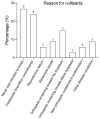Comparison of Cranial Cruciate Ligament Rupture Incidence among Parous and Nulliparous Rottweiler Bitches: Evidence from a Lifetime Cohort Study Supporting a Paradigm of Pregnancy-Associated Protection against Subsequent Non-Reproductive Disease Outcomes
- PMID: 39272393
- PMCID: PMC11394030
- DOI: 10.3390/ani14172608
Comparison of Cranial Cruciate Ligament Rupture Incidence among Parous and Nulliparous Rottweiler Bitches: Evidence from a Lifetime Cohort Study Supporting a Paradigm of Pregnancy-Associated Protection against Subsequent Non-Reproductive Disease Outcomes
Abstract
Emerging evidence in women supports the notion that pregnancy may reset disease resistance, thereby providing protection against subsequent adverse health outcomes, but this hypothesis has not been adequately explored in domestic dogs. Cranial cruciate ligament (CCL) rupture is a degenerative orthopedic disease that frequently affects pet dogs, and its risk has been associated with disruption of the reproductive hormone axis. Our research team is conducting a lifetime cohort study of purebred Rottweilers in North America that have lived 30% longer than breed-average. Detailed medical and reproductive histories of 33 nulliparous and 32 parous Rottweilers were generated from questionnaires and review of medical records. Interviews with owners of bitches in the nulliparous group served to limit selection bias, confirming that in no instance was the reason for nulliparity based upon the owner's suspicion that a bitch had a heightened risk for CCL rupture. The risk of CCL rupture associated with parity and other exposure variables was estimated using multivariate logistic regression. Overall, CCL rupture was diagnosed in 17 of 65 (26%) bitches. Median age at first litter and CCL rupture were 3.6 and 6.5 years, respectively. Compared to nulliparous, parous bitches had a significant 94% reduction in CCL rupture risk adjusted for duration of ovary exposure, overweight body condition, dietary pattern, habitual physical activity, and work/sport activity [ORadjusted (95% CI) = 0.06 (0.01-0.46); (p = 0.006)]. The observed parity-associated CCL rupture risk reduction remained robust in sensitivity analysis excluding six nulliparous bitches for which decision not to breed was based on diagnosis of hip or elbow dysplasia, conditions which may be genetically linked to CCL rupture [ORadjusted (95% CI) = 0.08 (0.01-0.58); (p = 0.01)]. This work sets the stage for replication studies in other canine populations that should begin to explore the mechanistic basis for parity-associated CCL rupture risk reduction and to pursue other non-reproductive health outcomes in bitches whose incidence or severity may be parity-sensitive.
Keywords: ACL rupture; cruciate ligament disease; dog; epigenetics; longevity; ovariohysterectomy; parity; reproduction; risk factors; risk reduction.
Conflict of interest statement
The authors declare no conflicts of interest.
Figures



References
-
- Zhou R., Liu H.M., Zou L.W., Wei H.X., Huang Y.N., Zhong Q., Gu S.Y., Chen M.F., Wang S.L., Sun H.X., et al. Associations of parity with change in global cognition and incident cognitive impairment in older women. Front. Aging Neurosci. 2022;14:864128. doi: 10.3389/fnagi.2022.864128. - DOI - PMC - PubMed
Grants and funding
LinkOut - more resources
Full Text Sources
Medical

